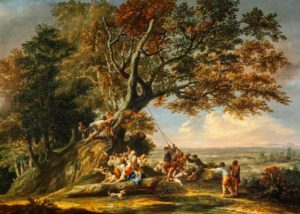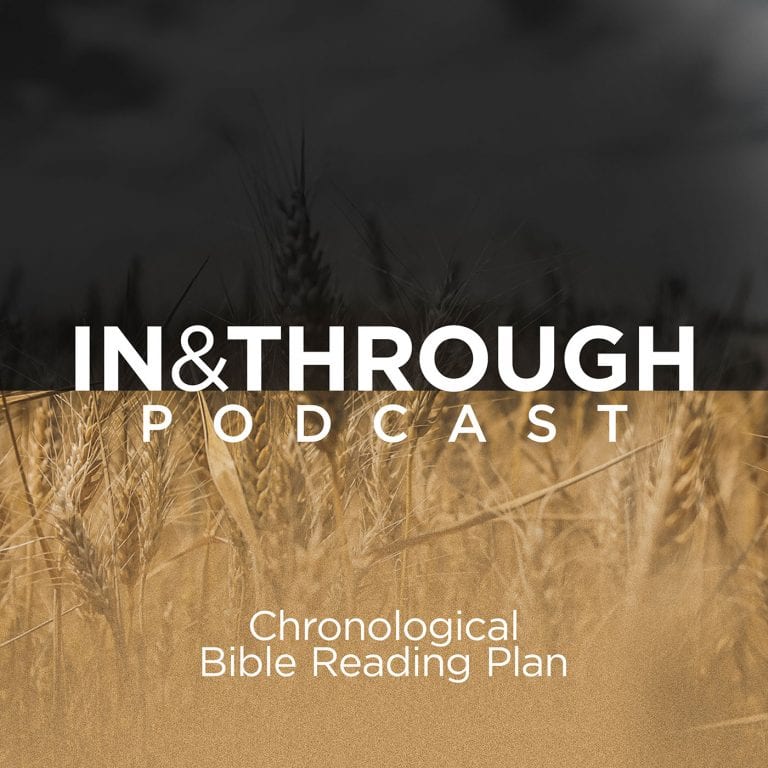Temples do not have very positive connotations in the 21st Century. People often think of temples as being bound up with stuffy religious things like idols, icons, and the like. In the Bible, temple is an indispensable and foundational category for our understanding.
So we must ask ourselves: What is the Bible’s true vision for the temple? We need to ask questions like: What story does the Bible tell with all of its temple language? Where does the Bible’s story of temple begin? Where does it take us?
The Biblical story begins with humanity being banished from God’s presence. The big problem in the Bible from the beginning is this: We have been separated from God. God designed a garden paradise in which humanity was to dwell with him forever. But because of sin, he exiled us from the Garden and his presence. And so Genesis 4 all the way through to Revelation 22 sets out to answer the question: “How can sinful humanity dwell with God again?” Its answer is temple.
Creation’s Garden Temple
The temple theme begins in Genesis 1-3 where temple gets introduced as the meeting place between God and humanity. The temple mediates the presence of God to his people. The Garden of Eden functions very much in this way.
Jim Hamilton says:
“Shakespeare showed his genius in a theatre named the globe. It would be the place where he would display the stories of his creative mind and heart. The real world, where God shows his genius, is the archetype of the theatre where Shakespeare showed his. God built this stage to show his craft. The world is a theater for the display of God’s glory…. It is the place where God is known, served, worshipped, and present.”[1]
Therefore, the world is God’s temple. Hamilton continues, “God built the earth as his temple, and in it he put his image and likeness. The realm that God has created is a cosmic temple; the image God put in the temple to represent himself is mankind.”[2] The world is God’s temple. Humanity is God’s image. The temple story begins on this foundation.
There is much evidence throughout Scripture that the Biblical authors view creation as a kind of temple structure. Genesis 3:8 says, “humanity heard the sound of the LORD God walking in the garden in the cool of the day.” The literal phrase there is “God walked to and fro.” This same phrase appears again when King David comes to God, wanting to build him a temple and the LORD said back to David, “Since the day I brought Israel up from Egypt, I have been moving about in a tent for my dwelling” (2 Sam 7:6-7). The language God uses for his moving about in the tabernacle picks up on the language God used for his moving to and fro in the garden.
In addition, the job description of the first temple dwellers, God’s first image-bearers, Adam and Eve, matches the job description of the first priests or temple-servants later on in the Bible. Adam and Eve also performed the first sacrifice in Scripture. We’re told, “The LORD God took the man and put him in the garden to work it and keep it” (Gen 2:15).
This language is only used elsewhere in the Bible to describe the Levitical priests. Numbers 3:5-7 says, “The LORD spoke to Moses saying, ‘Bring the tribe of Levi near… They shall keep guard over the whole congregation before the tent of meeting, as they work at the tabernacle.’”[3] In this sense, Adam and Eve, God’s temple images in the garden, were prototypes of what would one day become priests in the tabernacle.
Priests were those who offered sacrifices in the temple on behalf of their own sins and the sins of the people. And so too Adam would have his sins atoned for, and the sins of his wife, through a substitutionary sacrifice that would “cover” or atone for their sins (Gen 3:21).
The Wilderness Tabernacle
Eventually, Jacob, one of the patriarchs, a descendant of Adam, Noah, and Abraham, would have twelve sons, and their descendants wound up enslaved in Egypt (Ex 1:13). God heard the cries of his people, and raised up Moses to deliver Israel from their slavery (Ex 2:23-3:10). He delivered them through the Red Sea and into the wilderness (Ex 14).
Israel sojourned there for much longer than they would have hoped. God judged them by prolonging their wilderness wanderings for forty years because of their thankless and faithless grumbling and idolatry (Ex 16; 32). But as he did in the garden, God would not give up on dwelling with his people.
In the garden he pursued them in their sin by asking, “Where are you” (Gen 3:9)? And in the wilderness, he would pursue them yet again. God initiated the building of the tabernacle, where isolated sacrifices would be offered, just like the one in the garden of Eden. This was God’s way of reversing the curse of the fall. Humanity’s sin made it so that they could not dwell with the Holy God who made us. Our sin separated us from God’s presence. But the tabernacle would be his expression of “goodness and mercy pursuing us all the days of our lives that we might dwell in the house of the LORD forever” (Ps 23:6).
On the way to the promised land, God would pursue his sinful people with his presence, reminding them, through the temporary tabernacle dwelling, and through the repeated sacrifices of sheep and oxen, of their constant need for atonement, forgiveness, and cleansing.
The Jerusalem Temple
Once the people entered the promised land in the book of Joshua, it became for them a new kind of garden paradise – a new kind of temple. It was a land flowing with milk and honey (Josh 5:6), a land where God would once again dwell with his people. And here the temple pattern is established. The temple is promised (2 Sam 7:1-16), built (1 Kings 5-8), destroyed (2 Kings 25), and rebuilt (Ezra 3). God promised David that his son would build his house and reign forever and ever.
Solomon partially fulfilled this promise by building the glorious Jerusalem temple., but he would not reign forever as king. He plummeted himself into idolatry and sin (1 Kings 11) and his descendants would rupture the kingdom of Israel in two (1 Kings 12), until Babylon became God’s instrument of judgement toward his people as they carried them off into exile. They burned and pillaged the city of Jerusalem, destroyed its temple, and seemingly eliminated the hope of God dwelling with his people again.
And even when the new temple was built, once the people returned from exile, those who knew of the glory of the first temple wept, as God’s presence would not gloriously manifest itself there as it had before (Ezra 3:13).
Jesus Christ the True Temple
When the Old Testament canon closes, readers of God’s temple story are led to ask whether all hope of God dwelling with his people was lost. But the ultimate fulfillment of God’s promise to David that his son would forever sit on the throne (2 Sam 7) would collide with the ultimate fulfillment of God’s promise to dwell inseparably with his people in Jesus Christ.
In Ezekiel 11:16 he says, “Although I have scattered you in the countries of the world, I will be a sanctuary to you.” In that promise, the Lord identifies himself with the temple. He promises to come and be the temple.
That promise is fulfilled in John 1:14, where we see the true and better temple built in the incarnation of Jesus Christ. “And the Word became flesh and dwelt (tabernacled) among us, and we have seen his glory, glory as of the Son from the Father, full of grace and truth.” Jesus Christ is the place where God would dwell with humanity, for “in him the fullness of deity dwells bodily” (Col 2:9). The ultimate place where God is known, served, worshiped and present is in Christ himself.
It wouldn’t take long, however, for humanity to tear that temple down. In John 2, Jesus enters the temple, and is asked for a sign. And he answers, “’Destroy this temple, and in three days I will raise it up…’ But he was speaking about the temple of his body” (John 2:21).
The crucifixion is the ultimate destruction of the temple of God. The Resurrection is its ultimate rebuilding. The resurrection is God’s message that the only true and acceptable sacrifice, offered by his true and great high priest, Jesus Christ, has been accepted and approved (Heb 7:23-25).
Jesus Christ, the true temple, is promised, built, destroyed and rebuilt, just like Solomon’s temple in Jerusalem.
The Church as Spiritual Temple
Because of Jesus, the true temple, and Jesus the true sacrifice, and Jesus the great high priest, and his death and resurrection, God’s Holy Spirit would establish the church as God’s spiritual temple (1 Cor 6:19-20; Eph 2:19-22). In this new temple, God promises to be with his people always, even to the end of the age (Matt 28:18). In this place, a new race of garden priests would be raised up, a people of God’s own possession (1 Pet 2:4-5), such that each individual Christian and the corporate body of Christ, his church, would be the meeting place between God and sinners.
The church is the imperfect meeting place between God and humanity by the power of the Holy Spirit until Christ comes again. We can enjoy God’s presence in a way David and Solomon could never have anticipated.
The New Jerusalem Temple
In Revelation, the New Jerusalem is described as a kind of cube (Rev 21:16). It’s a new kind of Holy of Holies (2 Chron 3:18). It promises to function as the eternal dwelling place of God with his people (Rev 21:3). It will be a new garden-city paradise (Rev 22:1-5) with “the river of the water of life flowing from the throne of God and of the Lamb.” It will be a city where “no longer will there be anything accursed, but the throne of the Lamb will be in it, and his servants will worship him” (Rev 22:3).
We will forever be in God’s temple, the eternal place where God is known, served, worshipped, and present. Redeemed sinners, then sanctified, and glorified, will dwell forever with a Holy God because the Lamb who was slain ransomed them and ushers them into his presence forever in the perfect temple dwelling of God.
The story of temple gives humanity hope, that in spite of our sin, because of Jesus Christ, the true temple, we will forever dwell in the place called “The LORD is there” (Ezek 48:35). In that place, the Lord God the Almighty and the Lamb will be the temple (Rev 21:22).
We will dwell with him there as God’s priests, God’s people, God’s servants, God’s family, and God’s bride. He will wipe away every tear from our eyes, and death will be no more (Rev 21:4). No more crying, no more pain, no more separation from God.
[1] Hamilton, What is Biblical Theology: A Guide to the Bible’s Story, Symbolism, and Patterns, 27.
[2] Ibid., 28.
[3] Wenham, Sanctuary Symbolism in the Garden of Eden.






















